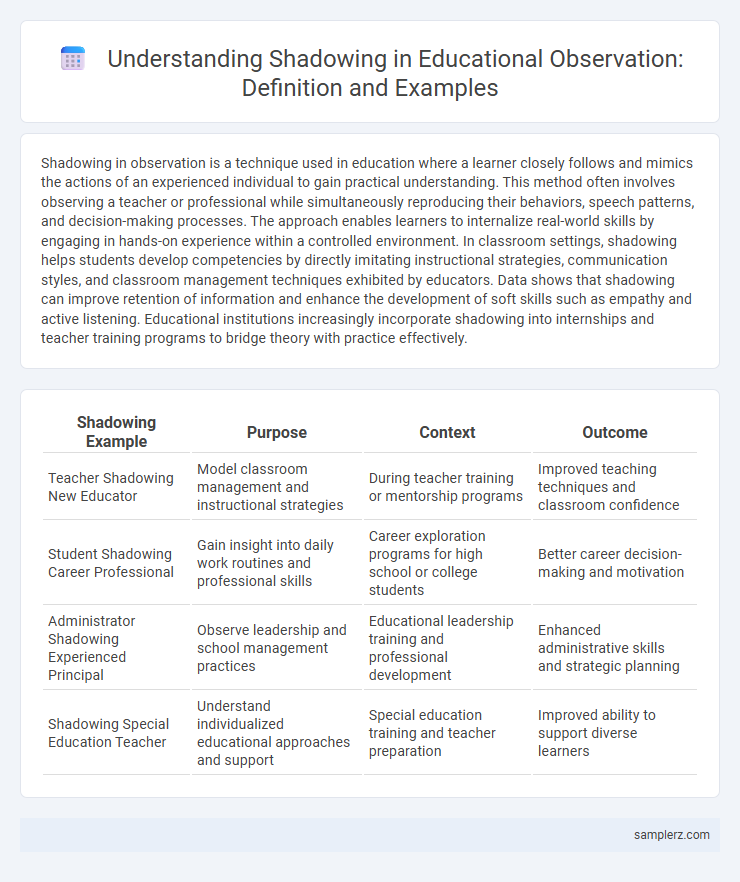Shadowing in observation is a technique used in education where a learner closely follows and mimics the actions of an experienced individual to gain practical understanding. This method often involves observing a teacher or professional while simultaneously reproducing their behaviors, speech patterns, and decision-making processes. The approach enables learners to internalize real-world skills by engaging in hands-on experience within a controlled environment. In classroom settings, shadowing helps students develop competencies by directly imitating instructional strategies, communication styles, and classroom management techniques exhibited by educators. Data shows that shadowing can improve retention of information and enhance the development of soft skills such as empathy and active listening. Educational institutions increasingly incorporate shadowing into internships and teacher training programs to bridge theory with practice effectively.
Table of Comparison
| Shadowing Example | Purpose | Context | Outcome |
|---|---|---|---|
| Teacher Shadowing New Educator | Model classroom management and instructional strategies | During teacher training or mentorship programs | Improved teaching techniques and classroom confidence |
| Student Shadowing Career Professional | Gain insight into daily work routines and professional skills | Career exploration programs for high school or college students | Better career decision-making and motivation |
| Administrator Shadowing Experienced Principal | Observe leadership and school management practices | Educational leadership training and professional development | Enhanced administrative skills and strategic planning |
| Shadowing Special Education Teacher | Understand individualized educational approaches and support | Special education training and teacher preparation | Improved ability to support diverse learners |
Understanding Shadowing in Educational Observation
Shadowing in educational observation involves closely following a student or teacher throughout their daily activities to gain real-time insights into learning behaviors and instructional methods. This technique captures authentic interactions and environmental factors influencing education, providing valuable data for tailored interventions and professional development. Effective shadowing enhances understanding of classroom dynamics and supports evidence-based improvements in teaching strategies.
Key Principles of Effective Shadowing
Effective shadowing in education involves active observation of teaching strategies, classroom management, and student engagement. Key principles include maintaining confidentiality, asking insightful questions without interrupting, and reflecting on observed practices to enhance professional growth. Shadowing promotes experiential learning, fostering deeper understanding of instructional methods and school culture.
Shadowing a Teacher: Classroom Dynamics
Shadowing a teacher involves closely observing classroom dynamics to understand instructional strategies, student engagement, and classroom management techniques. By following the teacher's interactions with students during lessons, one gains insights into effective communication, pacing, and the use of educational resources. This immersive experience highlights real-time decision-making and adaptation, essential for developing practical teaching skills.
Shadowing Student Behavior and Interaction
Shadowing student behavior and interaction involves closely monitoring how students engage with peers and instructors during class activities to gather real-time data on social dynamics and learning habits. This method provides insights into participation patterns, communication styles, and response to instructional strategies, aiding educators in tailoring support for diverse learning needs. Documented observations through shadowing help identify both strengths and challenges in student interactions, promoting targeted interventions that enhance overall classroom engagement.
Documenting Observations During Shadowing
Documenting observations during shadowing involves meticulously recording specific behaviors, interactions, and environmental factors to capture an accurate representation of the observed educational setting. Detailed notes, audio recordings, and video documentation enhance data reliability and support comprehensive analysis. Effective documentation techniques enable educators to identify patterns and inform instructional strategies for improved student engagement.
Ethical Considerations in Shadowing Practice
Shadowing in educational observation requires strict adherence to ethical considerations such as obtaining informed consent from both the observer and the observed, ensuring confidentiality of student information, and respecting the privacy of all participants. Observers must avoid any actions that could influence or disrupt the natural learning environment, maintaining professional boundaries throughout the process. Ethical shadowing practices contribute to reliable data collection and foster trust between educators, students, and researchers.
Shadowing Special Needs Support in Schools
Shadowing special needs support staff in schools provides firsthand insight into personalized learning strategies and behavioral interventions used to assist students with diverse abilities. Observers gain valuable understanding of adaptive communication techniques and individualized support plans tailored to enhance student engagement and academic success. This practical experience fosters improved collaboration between educators and support specialists, promoting inclusive educational environments.
Role of Shadowing in Teacher Training Programs
Shadowing in teacher training programs enables trainees to observe experienced educators' classroom management and instructional techniques firsthand, enhancing their practical understanding of effective teaching strategies. This observational method allows pre-service teachers to internalize best practices related to student engagement, assessment, and differentiated instruction. By immersing in real classroom environments, shadowing bridges theoretical knowledge with practical application, accelerating professional development.
Challenges Encountered During Shadowing
Challenges encountered during shadowing in education often include communication barriers between the observer and the teacher, which may hinder effective information exchange. Limited access to classroom activities due to privacy concerns or school policies can restrict observation opportunities and data collection. Time constraints and scheduling conflicts also pose significant challenges, impacting the observer's ability to gain comprehensive insights into teaching methods and student interactions.
Reflecting on the Shadowing Experience in Education
Reflecting on the shadowing experience in education reveals how observing skilled educators enhances understanding of effective teaching strategies and classroom management techniques. This process deepens insights into student engagement, curriculum delivery, and adaptive instruction methods, fostering professional growth. Evaluating these observations supports continuous improvement and informs personalized teaching approaches for better learner outcomes.

example of shadowing in observation Infographic
 samplerz.com
samplerz.com